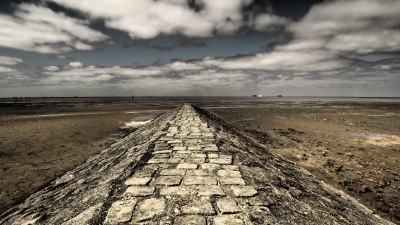The Hidden History Behind Places We Visit Without Thinking Twice
Explore the fascinating history behind everyday places, uncovering stories that shape our experiences.

Image by freepic-diller on Freepik
We often pass by the same places daily without a second thought, yet behind the mundane facades lie stories waiting to be uncovered. The history hidden within our surroundings can transform our understanding of the places we frequent, adding a rich layer of depth to our everyday experiences. From bustling coffee shops to quiet parks, each location has been shaped by events, people, and cultural influences that deserve recognition. In this article, we will delve into the hidden historical narratives behind several common places we frequently visit, revealing the past that informs their present.
Coffee Shops: More Than Just a Caffeine Stop
Coffee shops have become a staple in modern culture, serving as hubs for social interaction, work spaces, or simply a place to grab a quick caffeine fix. However, the first coffeehouses originated in the Middle East during the 15th century, and by the 17th century, they had spread to Europe, particularly in cities like London and Paris. These establishments were gathering spots for intellectuals and coffee enthusiasts, where ideas flowed as freely as the coffee. The infamous 'Penny Universities' in England offered a cup of coffee for the price of a penny and served as venues for stimulating conversations about politics, culture, and society.
Parks: Nature's Sanctuary with a Story
Public parks are often seen as mere recreational spaces where families gather, friends picnic, and individuals stroll. However, many urban parks have rich histories tied to their creation and evolution. Central Park in New York City, for instance, was designed during a tumultuous time amidst rising industrialization. It was intended to provide a respite from the bustling city, but it also held deeper societal implications regarding green spaces and public health. Many parks were created to promote physical well-being and foster community engagement, reflecting societal shifts towards valuing public and accessible spaces amidst industrial development.
Train Stations: Emblems of Connection
Train stations are more than mere transit points; they are symbols of connectivity and progress. The grand architecture of railway stations like Grand Central Terminal in New York and St. Pancras in London reflects the peak of the industrial age. These structures were not just built for functionality but were also meant to inspire pride and showcase a city’s growth. The history of rail travel is intertwined with economic growth, urban expansion, and the globalization of cultures, making train stations pivotal in shaping the movement of people, goods, and ideas.
Libraries: Gateways to Knowledge
Libraries are often perceived as quiet places filled with books, but they serve as historical centers of knowledge and progress. The Great Library of Alexandria, established in the 3rd century BCE, was the ancient world's premier knowledge repository, influencing scores of philosophers, scientists, and scholars. Although the Great Library no longer exists, the modern library has emerged from its legacy, advocating for education, literacy, and equal access to information. Public libraries today continue this tradition, adapting to modern technology while remaining beacons of knowledge within their communities.
Bridges: Architecture with Purpose
Bridges are crucial for transportation, often taken for granted as we cross them daily. However, each bridge typically has a unique story tied to its construction, purpose, and the geographic challenges it overcame. The Golden Gate Bridge in San Francisco, for example, faced significant engineering hurdles due to its location and strong winds. Completed in 1937, it became an iconic symbol not just of the city, but also of human ingenuity and the spirit of exploring new connections. Bridges also represent the historical narratives of communities, including those surrounding transportation development and socioeconomic growth.
The Evolution of Streets
Streets are the veins of our cities, intricately woven into the fabric of urban life. The historical development of streets often reflects changing transportation needs, technological advancements, and societal movements. For instance, Beacon Street in Boston traces its origins back to the 1600s when it served as a critical route for early settlers. Over time, it evolved in response to the city’s growth, with streetcars later becoming integral to urban mobility. As we walk down streets named after historical figures or events, we tread on paths that have witnessed changes in governance, culture, and community dynamics.
Museums: Preserving the Past
Museums are dedicated to preserving history, art, and culture, yet many visitors may overlook the stories encapsulated within their walls. The Louvre in Paris, once a royal palace, is now a symbol of art and history, housing thousands of artifacts and artworks that amplify human creativity and experience. Museums often reflect the socio-political narratives of their time, showcasing shifts in cultural appreciation and education. Many modern museums strive to provide a platform for underrepresented voices, ensuring that the histories of diverse communities are heard and acknowledged in the broader narrative landscape.
Churches and Temples: Sacred Spaces with History
Places of worship hold profound significance in communities, serving as centers for spiritual gatherings and communal support. However, their historical narratives often mirror broader societal changes. The evolution of cathedrals, mosques, and temples throughout history illustrates the progression of religious thought, community identity, and architectural advancements. For instance, the Notre-Dame Cathedral in Paris, a masterpiece of Gothic architecture, has witnessed centuries of French history, including revolutions and wars. It stands as a testament to both faith and resilience, embodying the intricate relationship between spirituality and societal evolution.
Shopping Districts: Commercial History
Shopping districts are more than venues for commerce; they are, in fact, snapshots of historical economic trends and consumer habits. The rise of the shopping mall emerged in the mid-20th century, transforming how retail spaces were designed and experienced. While these districts may seem modern, they are often built upon older market systems that highlight an evolution in buying and selling practices throughout history. Places like London's Covent Garden or the historic markets in Istanbul link past with present, continuously adapting to reflect contemporary consumer trends while retaining their historical identities.
Cemeteries: Silent Histories
Cemeteries are often overlooked as serene resting places, yet they hold significant historical importance. Each gravestone tells a story, chronicling the lives and legacies of individuals that have shaped their communities. Historical cemeteries such as the Pere Lachaise Cemetery in Paris or Arlington National Cemetery in Virginia are not just burial grounds—they are revered spaces where history and memory intertwine. They remind us of the collective narratives of communities, preserving the memories of those who came before us and reflecting cultural practices surrounding death and remembrance.
A Deeper Connection
Everyday places we encounter are imbued with a rich tapestry of history that enriches our perspective on life. By exploring the stories behind our surroundings, we can cultivate a deeper appreciation for the connections we share with our environment and the people within it. Understanding the past can inform our present and inspire our future, encouraging us to recognize the significance of the seemingly ordinary. Next time you pass by your local coffee shop, park, or library, consider the hidden histories they may harbor—stories that, when acknowledged, can transform the way we perceive our daily interactions and experiences.











